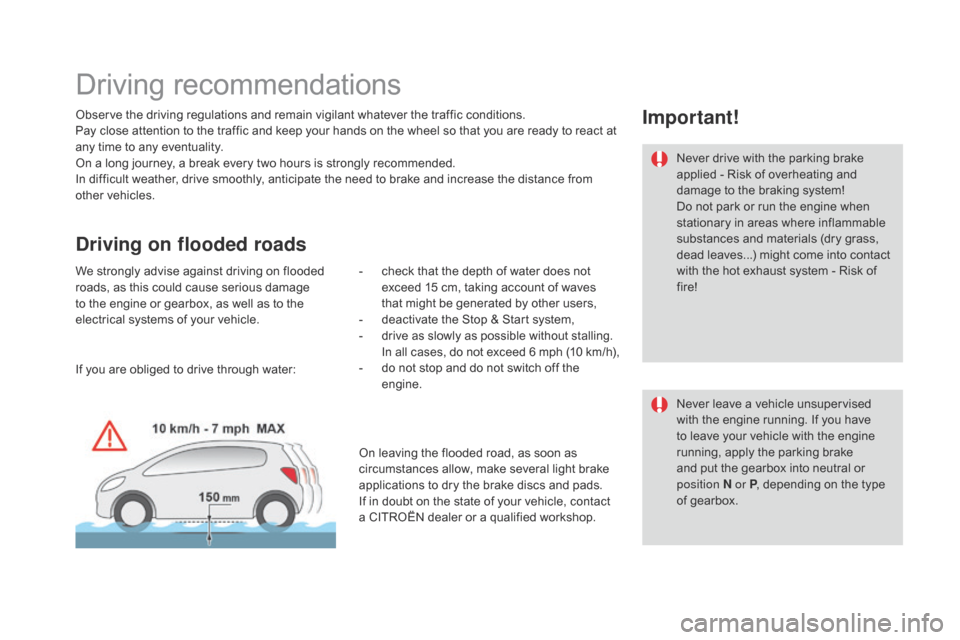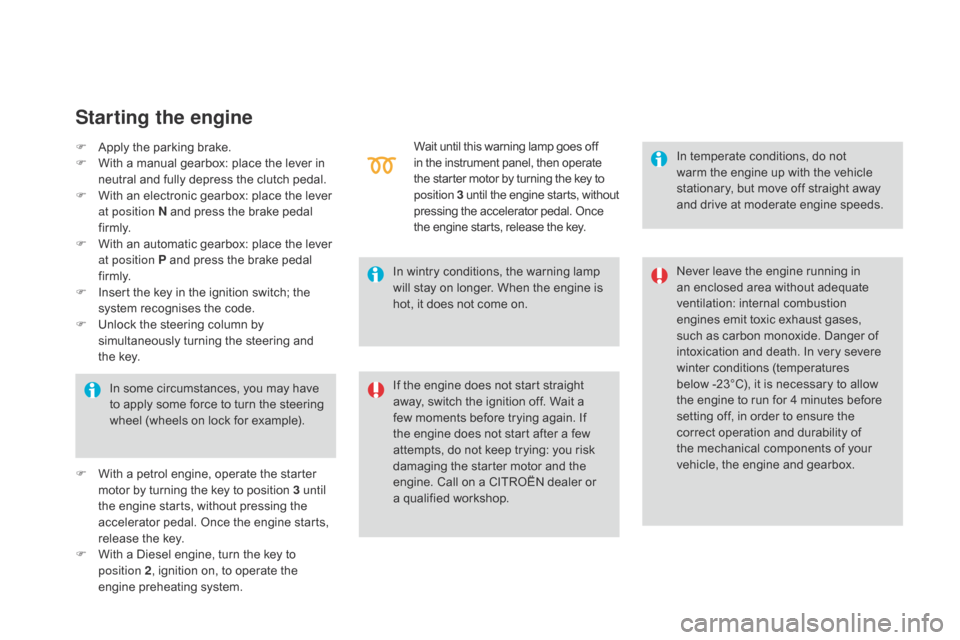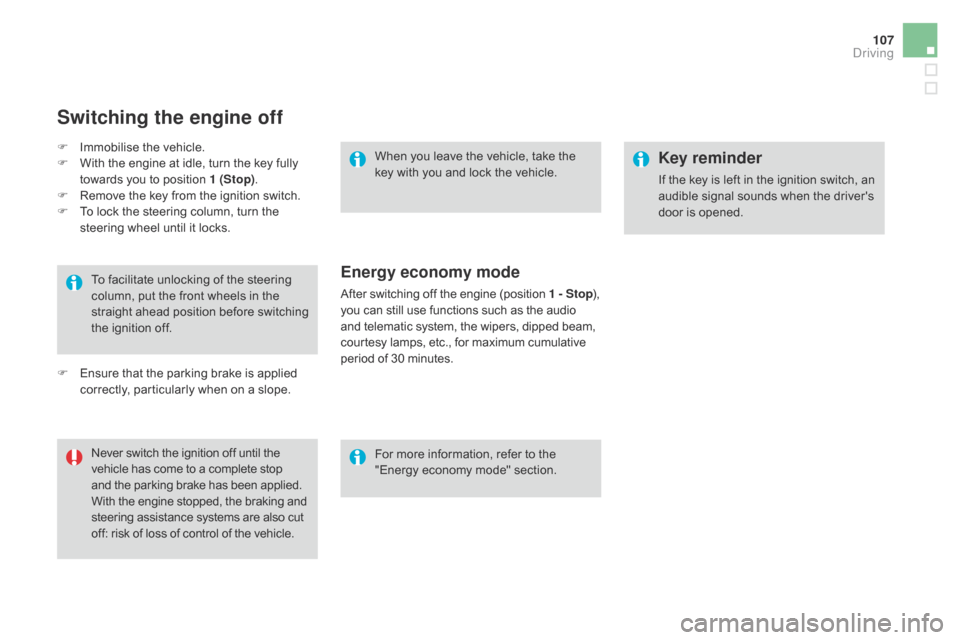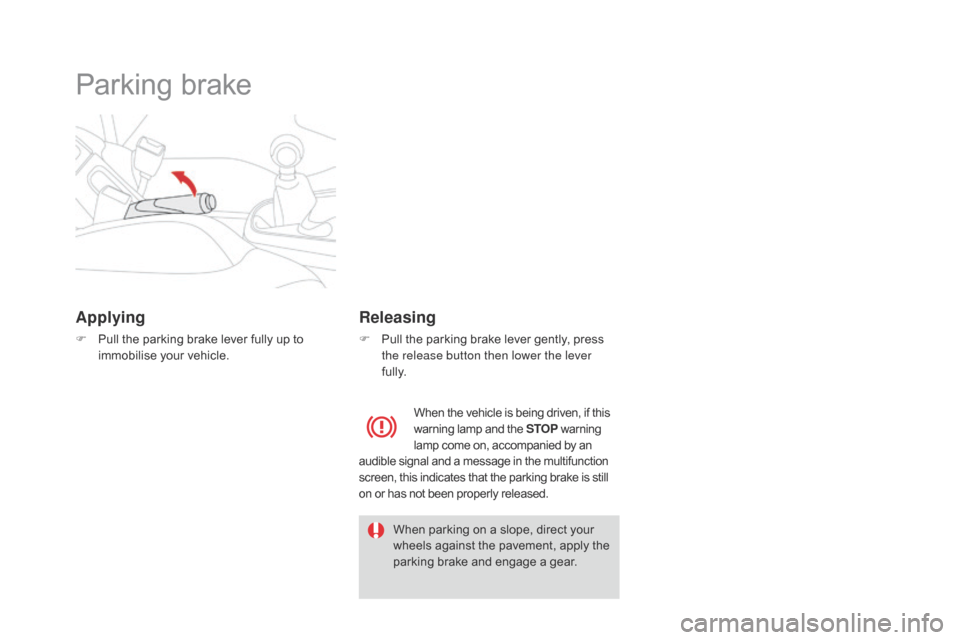parking brake Citroen DS3 RHD 2016 1.G Owner's Manual
[x] Cancel search | Manufacturer: CITROEN, Model Year: 2016, Model line: DS3 RHD, Model: Citroen DS3 RHD 2016 1.GPages: 380, PDF Size: 10.11 MB
Page 26 of 380

Warning/indicator lampis on Cause Action / Observations
di
esel engine
pre-heating fixed.
The
 key  is  at  position  2  (ignition  on)  in Â
t
he  ignition  switch.Wait
 until  the  warning  lamp  goes  off  before  starting.
The
 period  of  illumination  of  the  warning  lamp  is Â
d
etermined  by  the  ambient  conditions  (up  to  about Â
t
hirty  seconds  in  very  low  temperatures).
If
 the  engine  does  not  start,  switch  the  ignition  off  and Â
t
hen  on,  wait  until  the  warning  lamp  goes  off  again, Â
t
hen  start  the  engine.
Parking brake fixed. The
 parking  brake  is  applied  or  not Â
p
roperly
 r
eleased.Release
 the  parking  brake  to  switch  off  the  warning Â
l
amp,  keeping  your  foot  on  the  brake  pedal.
Observe
 the  safety  recommendations.
For
 more  information  on  the  parking  brake,  refer  to  the Â
c
orresponding
 s
ection.
Stop & Star t fixed. When
 the  vehicle  stops  (red  lights,
 t
raffic  jams, ...)  the  Stop  &  Start  system
 h
as  put  the  engine  into  STOP  mode.The
 warning  lamp  goes  off  and  the  engine  restarts Â
a
utomatically  in  START  mode,  as  soon  as  you  want  to Â
m
ove  off.
flashes for a few
seconds,
 then  goes  off.STOP
 mode  is  temporarily Â
u
navailable.
or
START
 mode  is  invoked Â
au
tomatically.For
 more  information  on  Stop  &  Start,  refer  to  the Â
c
orresponding
 s
ection.
Page 27 of 380

25
Foot on the
brake pedalfixed.
The  brake  pedal  must  be  pressed. With  an  electronic  gearbox,  press  the  brake  pedal  to  s
tart  the  engine  (lever  in  position  n) . Â
W
ith  an  automatic  gearbox,  with  the  engine  running, Â
p
ress  the  brake  pedal  before  releasing  the  parking Â
b
rake,  to  unlock  the  lever  and  come  out  of  position  P.
If
 you  wish  to  release  the  parking  brake  without Â
p
ressing  the  brake  pedal,  this  warning  lamp  will Â
r
emain  on.
flashing. With
 an  electronic  gearbox,  if  you Â
h
old  the  vehicle  on  an  incline  using Â
t
he  accelerator  for  too  long,  the Â
c
lutch  overheats.Use
 the  brake  pedal  and/or  the  parking  brake.
Automatic
wiping fixed.
The
 wiper  control  is  pushed Â
d
ownwards.Automatic
 front  wiping  is  activated.
Warning
/indicator lampis on Cause Action / Observations
Monitoring
Page 53 of 380

51
"driving" menu
ButtonCorresponding function Comments
di
agnostic Recap
 of  current  alerts.
Under-inflation initialisation Reinitialisation
 of  tyre  pressures.
Refer
 to  the  "Safety"  section.
Vehicle settings Access
 to  other  functions  with  settings  that  can  be  adjusted.  The  functions  are  grouped Â
t
ogether  under  three  tabs:
-
Â
"dr
iving assistance"
-
Â
"
Automatic  rear  wiper  in  reverse"  (Activation  of  rear  wiper  coupled  to  reverse  gear;  see Â
t
he  " Visibility"  section).
-
Â
"
Parking  sensors"  (Activation  of  rear  parking  sensors;  refer  to  the  "Driving"  section).
-
Â
"
Auto  emergency  braking"  (Active  City  Brake;  refer  to  the  "Safety"  section).
-
Â
"L
ighting"
-
Â
"
Mood  lighting"  (refer  to  the  " Visibility"  section).
-
Â
"
Guide-me-home  lighting"  (Automatic  guide  me  home  lighting;  refer  to  the  " Visibility" Â
s
ection).
Select
 or  deselect  the  tabs  at  the  bottom  of  the  screen  to  display  the  functions  required.
The
 functions  accessible  in  this  menu  are  given  in  the  table  below.
Monitoring
Page 106 of 380

Driving recommendations
Observe the driving regulations and remain vigilant whatever the traffic conditions.
P ay  close  attention  to  the  traffic  and  keep  your  hands  on  the  wheel  so  that  you  are  ready  to  react  at Â
a
ny  time  to  any  eventuality.
On
 a  long  journey,  a  break  every  two  hours  is  strongly  recommended.
In
 difficult  weather,  drive  smoothly,  anticipate  the  need  to  brake  and  increase  the  distance  from Â
o
ther
 v
ehicles.
driving on flooded roads
We strongly advise against driving on flooded roads,  as  this  could  cause  serious  damage Â
t
o  the  engine  or  gearbox,  as  well  as  to  the Â
e
lectrical  systems  of  your  vehicle.
Important!
Never drive with the parking brake applied  -  Risk  of  overheating  and Â
d
amage  to  the  braking  system!
Do
 not  park  or  run  the  engine  when Â
s
tationary  in  areas  where  inflammable Â
s
ubstances  and  materials  (dry  grass, Â
d
ead  leaves...)  might  come  into  contact Â
w
ith  the  hot  exhaust  system  -  Risk  of Â
f
ire!
Never
 leave  a  vehicle  unsupervised Â
w
ith  the  engine  running.  If  you  have Â
t
o  leave  your  vehicle  with  the  engine Â
r
unning,  apply  the  parking  brake Â
a
nd  put  the  gearbox  into  neutral  or Â
p
osition
n or P,
 depending  on  the  type Â
o
f  gearbox.
-
Â
c
heck
Â
that
Â
the
Â
depth
Â
of
Â
water
Â
does
Â
not
Â
e
xceed
Â
15
Â
cm,
Â
taking
Â
account
Â
of
Â
waves
Â
t
hat
Â
might
Â
be
Â
generated
Â
by
Â
other
Â
users,
-
Â
d
eactivate
Â
the
Â
Stop
Â
&
Â
Start
Â
system,
-
Â
drive as slowly as possible without stalling. I n all cases, do not exceed 6 mph (10 km/h),
- do not  stop  and  do  not  switch  off  the  e
ngine.
If
Â
you
Â
are
Â
obliged
Â
to
Â
drive
Â
through
Â
water:
On
 leaving  the  flooded  road,  as  soon  as Â
c
ircumstances  allow,  make  several  light  brake Â
a
pplications  to  dry  the  brake  discs  and  pads.
If
 in  doubt  on  the  state  of  your  vehicle,  contact Â
a
 CITROËN  dealer  or  a  qualified  workshop.
Page 108 of 380

F Apply the  parking  brake.
F  W ith  a  manual  gearbox:  place  the  lever  in Â
n
eutral  and  fully  depress  the  clutch  pedal.
F
Â
W
ith  an  electronic  gearbox:  place  the  lever Â
a
t position n and  press  the  brake  pedal Â
f
i r m l y.
F
Â
W
ith  an  automatic  gearbox:  place  the  lever Â
a
t position P  and  press  the  brake  pedal Â
f
i r m l y.
F
Â
I
nsert  the  key  in  the  ignition  switch;  the Â
s
ystem  recognises  the  code.
F
Â
U
nlock  the  steering  column  by Â
s
imultaneously  turning  the  steering  and Â
t
he key.
Starting the engine
In some circumstances, you may have to  apply  some  force  to  turn  the  steering Â
w
heel  (wheels  on  lock  for  example).In
 wintry  conditions,  the  warning  lamp Â
w
ill  stay  on  longer.  When  the  engine  is Â
h
ot,  it  does  not  come  on.In  temperate  conditions,  do  not Â
w
arm  the  engine  up  with  the  vehicle Â
s
tationary,  but  move  off  straight  away Â
a
nd  drive  at  moderate  engine  speeds.
If  the  engine  does  not  start  straight  a
way,  switch  the  ignition  off.  Wait  a Â
f
ew  moments  before  trying  again.  If Â
t
he  engine  does  not  start  after  a  few Â
a
ttempts,  do  not  keep  trying:  you  risk Â
d
amaging  the  starter  motor  and  the Â
e
ngine.  Call  on  a  CITROĂ‹N  dealer  or Â
a q
ualified  workshop.Never
 leave  the  engine  running  in Â
a
n  enclosed  area  without  adequate Â
v
entilation:
 in
ternal
 c
ombustion
 e
ngines  emit  toxic  exhaust  gases, Â
s
uch  as  carbon  monoxide.  Danger  of Â
i
ntoxication  and  death.  In  very  severe Â
w
inter  conditions  (temperatures  b
elow -23°C),  it  is  necessary  to  allow  t
he  engine  to  run  for  4  minutes  before Â
s
etting  off,  in  order  to  ensure  the Â
c
orrect  operation  and  durability  of Â
t
he  mechanical  components  of  your Â
v
ehicle,  the  engine  and  gearbox.
F
Â
W
ith  a  petrol  engine,  operate  the  starter Â
m
otor  by  turning  the  key  to  position  3 until
the
 engine  starts,  without  pressing  the Â
a
ccelerator  pedal.  Once  the  engine  starts, Â
r
elease  the  key.
F
Â
W
ith  a  Diesel  engine,  turn  the  key  to Â
p
osition 2 ,
 ignition  on,  to  operate  the Â
eng
ine
 p
reheating
 s
ystem. Wait
 until  this  warning  lamp  goes  off
 i
n  the  instrument  panel,  then  operate
 t
he  starter  motor  by  turning  the  key  to
 p
osition
3
Â
until  the  engine  starts,  without
 p
ressing  the  accelerator  pedal.  Once
 t
he  engine  starts,  release  the  key.
Page 109 of 380

107
To facilitate unlocking of the steering column,  put  the  front  wheels  in  the Â
s
traight Â
a
head Â
p
osition Â
b
efore Â
s
witching Â
t
he  ignition  off.
Never
 switch  the  ignition  off  until  the
 v
ehicle  has  come  to  a  complete  stop
 a
nd  the  parking  brake  has  been  applied.
 W
ith  the  engine  stopped,  the  braking  and
 s
teering  assistance  systems  are  also  cut
 o
ff:  risk  of  loss  of  control  of  the  vehicle.When
 you  leave  the  vehicle,  take  the Â
k
ey  with  you  and  lock  the  vehicle.
For  more  information,  refer  to  the Â
"
Energy  economy  mode"  section.
Key reminder
If the key is left in the ignition switch, an audible  signal  sounds  when  the  driver's Â
d
oor  is  opened.
Switching the engine off
F Immobilise  the  vehicle.
F  W ith  the  engine  at  idle,  turn  the  key  fully Â
t
owards  you  to  position  1 (Stop).
F
Â
R
emove  the  key  from  the  ignition  switch.
F
Â
T
o  lock  the  steering  column,  turn  the Â
s
teering  wheel  until  it  locks.
F
Â
E
nsure  that  the  parking  brake  is  applied Â
c
orrectly,  particularly  when  on  a  slope.
Energy economy mode
After switching off the engine (position 1 - Stop), y
ou  can  still  use  functions  such  as  the  audio a
nd  telematic  system,  the  wipers,  dipped  beam,
 c
ourtesy  lamps,  etc.,  for  maximum  cumulative
 p
eriod  of  30  minutes.
driving
Page 110 of 380

Parking brake
Applying
F Pull the  parking  brake  lever  fully  up  to  i
mmobilise  your  vehicle.
Releasing
F Pull the  parking  brake  lever  gently,  press  t
he release button then lower the lever
fully.
When
 parking  on  a  slope,  direct  your Â
w
heels  against  the  pavement,  apply  the Â
p
arking  brake  and  engage  a  gear.
When
 the  vehicle  is  being  driven,  if  this
 w
arning  lamp  and  the  STOP
 w
arning
 l
amp  come  on,  accompanied  by  an
 a
udible  signal  and  a  message  in  the  multifunction
 s
creen,  this  indicates  that  the  parking  brake  is  still
 o
n  or  has  not  been  properly  released.
Page 113 of 380

111
display in the instrument panel
n. Neutral
R. R everse
1 2 3 4 5 / 6.
 Gears  in  manual  mode.
AUTO.
Â
Â
T
his  comes  on  when  automated  mode Â
i
s  selected.  It  goes  off  when  changing Â
t
o  manual  mode.
Moving off
F Select position n.
F  P ress  the  brake  pedal  fully.
F
Â
S
tart  the  engine.
n
 appears  in  the  instrument  panel.
If
 the  engine  does  not  start:
-
Â
I
f  n is  flashing  in  the  instrument Â
p
anel,  move  the  gear  selector  to Â
p
osition A, then to position
n
.F
 S elect  automated  mode  (position  A
), m
anual  mode  (position  M)  or  reverse Â
(
position
 R).
AU
TO
Â
and  1, 1 or R appear in the
instrument
 pan
el.
F
Â
R
elease  the  parking  brake.
F
Â
P
rogressively  take  your  foot  off  the  brake Â
ped
al.
Depending
 on  the  type  of  electronic Â
g
earbox,  the  vehicle  may  move  off  on Â
i
ts  own.
For
 more  information,  refer  to  the Â
"
Creep  function"  section.
Do
 not  press  the  brake  and  clutch Â
p
edals  simultaneously.  This  can  cause Â
r
apid  clutch  wear.
F
Â
A
ccelerate  away.
-
Â
I
f  this  warning  lamp Â
c
omes  on,  accompanied Â
b
y  an  audible  signal  and Â
t
he Â
d
isplay Â
o
f Â
a
Â
m
essage, Â
p
ress  firmly  on  the  brake Â
ped
al.
driving
Page 115 of 380

11 3
The gear change requests are only carried out if  the  engine  speed  permits.
It is not necessary to release the accelerator
pedal
 during  gear  changes.
When
 braking  or  slowing  down,  the  gearbox Â
c
hanges  down  automatically  so  that  the  vehicle Â
p
icks  up  in  the  right  gear.
Under
 full  acceleration,  the  change  up  will  not Â
t
ake  place  unless  the  driver  operates  the  gear Â
s
elector  or  steering  mounted  control  paddle Â
(
unless  the  engine  is  close  to  its  maximum Â
s
peed).
Reverse
To engage reverse, the vehicle must be immobilised  with  your  foot  on  the  brake.
F
Sel
ect position R .
Stopping the vehicle
Before switching off the engine:
-  c hange  to  position  n to be in neutral,
or
-
Â
l
eave  the  vehicle  in  gear;  in  this  case  the Â
v
ehicle  cannot  be  moved.
Manual mode
F Select position M.
The  gears  engaged  appear  in Â
s
uccession  in  the  instrument  panel.
You
 can  change  mode  at  any  time  by Â
m
oving  the  gear  selector  from  A to M or
the
 other  way  round.
Never
 select  neutral  (position  n
)
 when Â
m
oving. There
 is  an  audible  signal  on Â
enga
gement
 o
f
 r
everse.For
 all  parking  situations,  you  must
apply the parking brake
Â
to  immobilise Â
t
he  vehicle.
When
 immobilising  the  vehicle  with  the Â
e
ngine  running,  you  must  put  the  gear Â
s
elector  into  the  neutral  (position  n
).
B
efore  doing  anything  under  the Â
b
onnet,  ensure  that  the  gear  selector Â
i
s  in  neutral  (position  n
)
 and  that  the Â
p
arking  brake  is  applied.
At
 low  speed,  if  reverse  gear  is  requested, Â
t
he n warning  lamp  flashes  and  the  gearbox Â
g
oes  into  neutral  automatically.
To
 engage  reverse,  put  the  gear  selector  into Â
p
osition n
, t
hen to position R.
driving
Page 117 of 380

11 5
Four-speed automatic gearbox which offers a choice  between  the  comfort  of  fully  automatic Â
o
peration,  enhanced  by  sport  and  snow Â
p
rogrammes,
 o
r
 m
anual
 g
ear
 c
hanging.
Two
 driving  modes  are  available:
-
Â
a
utomatic operation with electronic
management
 of  the  gears  by  the  gearbox, Â
w
ith a sport
Â
programme  for  a  more Â
d
ynamic  style  of  driving  and  a  snow
programme
 to  make  driving  easier  when Â
g
rip  is  poor.
-
Â
m
anual
Â
operation  for  sequential  changing Â
o
f  the  gears  by  the  driver.
Automatic gearbox
1. Gear selector  knob.
2. B utton "S" (spor t) .
3.
Button "T " (snow) .
gear selection gate
P. Park.
-
 I mmobilisation  of  the  vehicle,  parking  brake Â
o
n  or  off.
-
Â
S
tarting  the  engine.
R.
 R
everse.
-
Â
R
eversing  manoeuvres,  vehicle  stationary, Â
e
ngine  at  idle.
n. N
eutral.
-
Â
I
mmobilisation  of  the  vehicle,  parking  brake Â
o
n.
-
Â
S
tarting  the  engine.
d
.
 A
utomatic
 ope
ration.
M + / -.
 Â
M
anual  operation  with  sequential Â
c
hanging  of  the  four  gears.
F
Â
P
ush  for wards  to  change  up  through  the Â
g
ears.
or
F
Â
P
ull  backwards  to  change  down  through Â
t
he  gears.
gear selector positions
driving